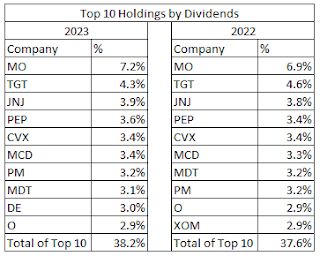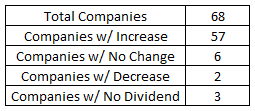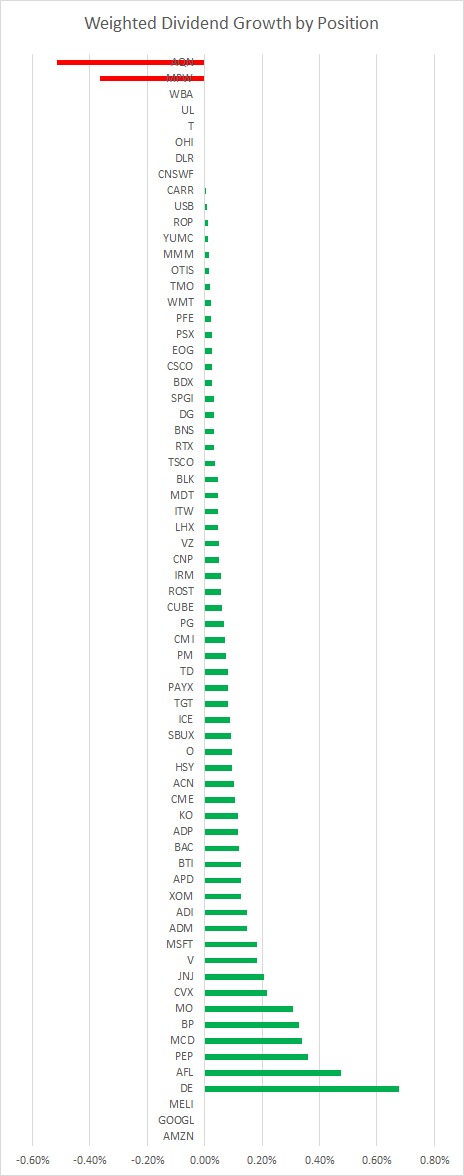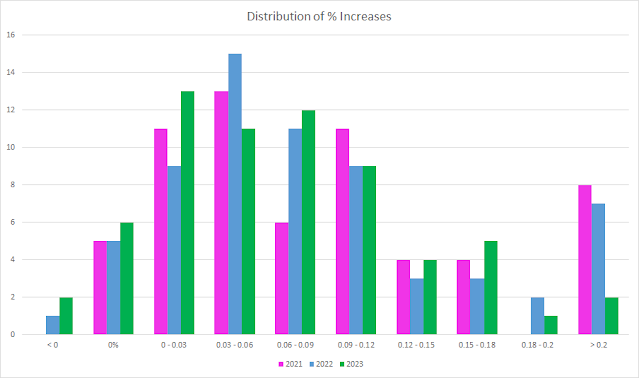Dividend Growth Checkup - 2023 #Dividend #DividendGrowth
And just like that 2023 has come to a close. It's hard to believe that another year has already passed us by and 2024 is well on its way. The turning of the calendar to a new year is typically a time of both reflection and planning. While this is very much a historical analysis, it helps to put things in context around where our portfolio has been in order to formulate a game plan for where we want it to go as well as how we want to get there.
While 2023 definitely could have gone better, complaints would fall on deaf ears and we can't change the past anyways.
The big news for 2023 was that my wife and I welcomed our 4th child into this world. Another daughter! Yep that's 4! Help me!
With the knowledge of another child on the way we stepped back from aggressively investing into our portfolio and preferred cash. We're also contemplating other potential investments that would be a big lifestyle change.
The majority of my investments are in what would be considered as dividend growth stocks. Companies that have consistently paid and grown their dividend payment to shareholders over time. The strategy appealed to me because it helps to keep me focused on the underlying business as well as my expectations moving forward rather that what Mr. Market is willing to buy or sell shares at today.
It's been scary at times as there's a lot of unknowns and the last few years alone have brought about a global pandemic, a supply chain crisis, war in Europe, a spike in inflation, and countless other issues. However, I sleep well at night as my dividends continue to churn higher, sometimes slower than I'd like, year after year as the businesses I own navigate the crisis du jour and hopefully come out stronger on the other side.
Compared to the end of 2022 my forward dividends for this account ended up 7.4% higher. This was a marked decline in growth, albeit still growth, compared to 2022's 18.5% rise; however, considering that very little capital was added to the account during the year the results were still pretty solid.
The total members represents the total number of positions that I own that pay at least that level of annual dividends. While the unique members are those companies that pay annual dividends between that level and the next level higher.
One of my goals for 2023 was to focus more on building up the size of positions. However, as life likes to do we stopped pushing all savings towards our portfolio with a preference to build up larger cash reserves as we adjusted to welcoming our 4th child into this world.
The $50 Club increased by 1 member compared to 2022 and now sits at 55 total members and 10 unique members.
The $100 Club rose by 2 members as well with 45 total members and 23 unique members.
The $200 Club saw no change in total members throughout 2023 with 22 total members and 8 unique members.
The $300 Club gained 2 members during the year bringing the total count to 14 with the unique members at 8.
Even though there's not a large member count in the next 4 levels it's encouraging to see what time, patience, and consistency has brought.
The $400 Club is up to 6 total members, an increase of 3 compared to 2022 and the largest member count among the club levels, with the unique member count rising to 4.
The $500 Club remained at 2 total members and 1 unique member.
There's no unique members in the $600 or $700 Club; however, the $800 Club was opened during 2023 with continued re-investment and dividend growth from Altria (MO).
Looking ahead to 2024 assuming modest dividend growth and reinvestment yields, I would expect the $400 Club to gain 1 members, the $300 Club to gain 1 member, and the $200 Club to gain 1-2 members. That's before accounting for additional fresh capital being deployed although with 3 kids in daycare I don't even know what that is.
The Top 10 holdings by dividends account for 38.2% of my forward dividends at end of year 2023. That was a modest increase in the Top 10 weighting from 2022 at 37.6%.
There was some minor shuffling among the top 10 constituents. The Top 6 positions all remained steady; however, ExxonMobil (XOM) dropped from the Top 10 altogether being replaced by Deere & Company (DE) which had another monster year of dividend growth.
Ideally, I want the bulk of my investments in what I consider the "sweet spot" which is somewhere around a 2.5% to 4.0% current yield with 5.0% to 10.0% annual dividend growth. In my opinion, that strikes a solid balance between adequate current dividend yield along with future dividend growth. Additionally I expect there to be a skew towards lower current yield.
The average increase for 2023 came to 5.5% while the average of just those that announced raises came to 7.9%. The previous years results were 10.2% and 8.5%, respectively.
For 2023, the median raise for just the growers came to 7.0%. That was a decrease from the 7.9% mark during 2022. For the entire portfolio, including the freezers and cutters, 2023's median raise was just 6.0% compared to 2022's 7.0%.
In order to calculate the weighted dividend growth rate, I use the 1-year dividend growth rate for Position X multiplied by the Dividends for Position X divided by the Total Dividends for the portfolio. I then repeat that for each position that I own and add them together to get the weighted dividend growth rate for the portfolio. The reason I do this is because the weighted dividend growth rate better reflects the organic dividend growth that you achieve across the portfolio.
Assume that you have a portfolio with just two holdings: Company A pays a 5.0% dividend yield with a 4.0% 1-year growth rate while Company B pays a 1.0% dividend yield with a 20.0% dividend growth rate. We'll assume at the start of the year you invest $10k in each company such that your starting dividends are $600 total. At the end of the year, each company raises its dividend by the respective growth rate, and your forward dividends at the end of the year are now $645.
The average dividend growth rate between those two companies is 12.5%; however, the weighted dividend growth rate is 7.5%. The weighted dividend growth rate is dragged lower due to Company A's outsized proportion of the provided dividends.
For 2023 the weighted dividend growth rate for my portfolio came to 5.3% compared to 2022's 6.7%. This was definitely a disappointment although unsurprising considering that 9.3% of my dividend weight provided no boost to their dividends or cut their dividends during the year.
The majority of my investments are in what would be considered as dividend growth stocks. Companies that have consistently paid and grown their dividend payment to shareholders over time. The strategy appealed to me because it helps to keep me focused on the underlying business as well as my expectations moving forward rather that what Mr. Market is willing to buy or sell shares at today.
It's been scary at times as there's a lot of unknowns and the last few years alone have brought about a global pandemic, a supply chain crisis, war in Europe, a spike in inflation, and countless other issues. However, I sleep well at night as my dividends continue to churn higher, sometimes slower than I'd like, year after year as the businesses I own navigate the crisis du jour and hopefully come out stronger on the other side.
Forward Dividends by Sector
I don't have a strict sector weighting plan; rather I keep more of a rough guideline in the back of my mind. However, instead of selling to reduce exposure to overweight sectors I prefer to tackle the sector exposure issue through additional savings and investments.Compared to the end of 2022 my forward dividends for this account ended up 7.4% higher. This was a marked decline in growth, albeit still growth, compared to 2022's 18.5% rise; however, considering that very little capital was added to the account during the year the results were still pretty solid.
Every sector except for utilities saw an increase in 2023 which was dragged lower by the dividend cut from Algonquin Power & Utilities (AQN). The technology sector saw the largest increase in percentage terms; however, the consumer discretionary sector was the largest dollar-wise.
The sector weightings aren't uber critical to me as many businesses fall into several categories. For example does Realty Income (O) fall under real estate or consumer discretionary or consumer staples, arguably it could be divided into all three. Same thing with Visa (V): is that financials or technology?
None of the sector weightings showed any significant deviation compared to the end of 2022. The largest change was only a 1.0% departure so there was definitely no meaningful adjustments made during 2023.
The consumer staples sector is the only one that I feel is really out of sorts for me; however, that's largely due to the premium that is typically placed on companies in those sectors. It's one of the few sectors that I'd like to increase my exposure too; however, I'm not going to go out of my way to do so.
The consumer staples sector is the only one that I feel is really out of sorts for me; however, that's largely due to the premium that is typically placed on companies in those sectors. It's one of the few sectors that I'd like to increase my exposure too; however, I'm not going to go out of my way to do so.
Dividend Clubs
Each year I like to examine my holdings to see how many provide different thresholds of annual dividends. I consider each level as its own "Dividend Club" based on the milestone level of dividends. In order to join one of the Dividend Clubs, the position needs to provide at least that level of forward dividends with the unique members being those that are capped out within that level.The total members represents the total number of positions that I own that pay at least that level of annual dividends. While the unique members are those companies that pay annual dividends between that level and the next level higher.
One of my goals for 2023 was to focus more on building up the size of positions. However, as life likes to do we stopped pushing all savings towards our portfolio with a preference to build up larger cash reserves as we adjusted to welcoming our 4th child into this world.
The $50 Club increased by 1 member compared to 2022 and now sits at 55 total members and 10 unique members.
The $100 Club rose by 2 members as well with 45 total members and 23 unique members.
The $200 Club saw no change in total members throughout 2023 with 22 total members and 8 unique members.
The $300 Club gained 2 members during the year bringing the total count to 14 with the unique members at 8.
Even though there's not a large member count in the next 4 levels it's encouraging to see what time, patience, and consistency has brought.
The $400 Club is up to 6 total members, an increase of 3 compared to 2022 and the largest member count among the club levels, with the unique member count rising to 4.
The $500 Club remained at 2 total members and 1 unique member.
There's no unique members in the $600 or $700 Club; however, the $800 Club was opened during 2023 with continued re-investment and dividend growth from Altria (MO).
Looking ahead to 2024 assuming modest dividend growth and reinvestment yields, I would expect the $400 Club to gain 1 members, the $300 Club to gain 1 member, and the $200 Club to gain 1-2 members. That's before accounting for additional fresh capital being deployed although with 3 kids in daycare I don't even know what that is.
Top 10 Holdings by Forward Dividends
My forward dividends are heavily weighted towards a handful of positions. That's partly by design and also due to many of the companies I'm invested in carrying meager dividend yields but that come with the potential for much faster dividend growth and capital gain potential. My top fifteen positions, by forward dividends, account for right around 50% of my expected 2023 dividends.The Top 10 holdings by dividends account for 38.2% of my forward dividends at end of year 2023. That was a modest increase in the Top 10 weighting from 2022 at 37.6%.
There was some minor shuffling among the top 10 constituents. The Top 6 positions all remained steady; however, ExxonMobil (XOM) dropped from the Top 10 altogether being replaced by Deere & Company (DE) which had another monster year of dividend growth.
Dividend Growth
My goal for 2023, as it was for 2022 and 2021, was to at least maintain the number of holdings. Last year saw no new increases to my position count.2023 was actually a year of very little activity in my FI Portfolio. There were no additions or deletions during the year as I held all the positions from the end of 2022 for the full year.
Much of that was due to the lack of additional capital being funneled to the account as well as being preoccupied with the new baby once July rolled around and researching other investment opportunities.
During 2023, 57 of my 68 holdings raised their dividends while 6 maintained their dividend. There were 2 dividend cuts, from the previously mentioned Algonquin Power & Utilities as well as Medical Properties Trust (MPW). There's still 3 holdings that do not pay a dividend.
Let's start with the companies that froze their dividend payment. The 6 freezers include Constellation Software (OTCPK:CNSWF) no surprise, Omega Healthcare Investors (OHI) no surprise, AT&T (T) no surprise, and Walgreens Boots Alliance (WBA) no surprise. Unilever plc (UL) and Digital Realty Trust (DLR) were a bit unexpected although considering DLR's leverage and the rising interest rate environment it wasn't too shocking.
In 2021, Constellation Software announced they will be forgoing dividend increases to preserve more capital for Mark Leonard and his team to devote to more acquisitions. Considering their prudent capital allocation approach and results, I'm just fine with that, and if they wanted to take back the meager $1 dividend, I wouldn't complain.
Omega Healthcare Investors (OHI) has been in limbo the last several years as their business was hit especially hard during COVID and had stumbles in prior years. I didn't expect a raise from them in 2023 so I wasn't disappointed with the lack of an increase. Thank goodness for low expectations! Of course a dividend yield that's been greater than 7% for the last few years helps to make up for that.
Let's start with the companies that froze their dividend payment. The 6 freezers include Constellation Software (OTCPK:CNSWF) no surprise, Omega Healthcare Investors (OHI) no surprise, AT&T (T) no surprise, and Walgreens Boots Alliance (WBA) no surprise. Unilever plc (UL) and Digital Realty Trust (DLR) were a bit unexpected although considering DLR's leverage and the rising interest rate environment it wasn't too shocking.
In 2021, Constellation Software announced they will be forgoing dividend increases to preserve more capital for Mark Leonard and his team to devote to more acquisitions. Considering their prudent capital allocation approach and results, I'm just fine with that, and if they wanted to take back the meager $1 dividend, I wouldn't complain.
Omega Healthcare Investors (OHI) has been in limbo the last several years as their business was hit especially hard during COVID and had stumbles in prior years. I didn't expect a raise from them in 2023 so I wasn't disappointed with the lack of an increase. Thank goodness for low expectations! Of course a dividend yield that's been greater than 7% for the last few years helps to make up for that.
AT&T wasn't much of a surprise considering they cut in 2022.
Unilever has now gone two years without a raise so we'll see what happens here in 2024. Unilever's EPS payout ratio dropped to the mid-50% area although their FCF payout ratio is still quite hefty around 70%.
Unilever has now gone two years without a raise so we'll see what happens here in 2024. Unilever's EPS payout ratio dropped to the mid-50% area although their FCF payout ratio is still quite hefty around 70%.
For a little bit of good news, Iron Mountain (IRM) announced a raise during 2023 and rejoined the dividend raiser class. It was a modest 5.1% increase, but I'll take it.
Dividend Yield vs Dividend Growth Rate
As a dividend growth investor that's relatively young, I aim to strike a balance between higher-yielding, but slower-growing companies with lower-yielding, but faster-growing businesses. While I love seeing those dividends hitting my account I realize that I'm not following this strategy to create the most income in the next 5 years; rather it's an attempt to set up a very rewarding portfolio 10-20 years down the line.Ideally, I want the bulk of my investments in what I consider the "sweet spot" which is somewhere around a 2.5% to 4.0% current yield with 5.0% to 10.0% annual dividend growth. In my opinion, that strikes a solid balance between adequate current dividend yield along with future dividend growth. Additionally I expect there to be a skew towards lower current yield.
Compared to 2022, 2023 looks fairly similar in terms of distribution between yields and growth rate.
Portfolio-Wide Dividend Growth
Dividend growth from my holdings continued to pull back during 2023 compared to 2022.The average increase for 2023 came to 5.5% while the average of just those that announced raises came to 7.9%. The previous years results were 10.2% and 8.5%, respectively.
For 2023, the median raise for just the growers came to 7.0%. That was a decrease from the 7.9% mark during 2022. For the entire portfolio, including the freezers and cutters, 2023's median raise was just 6.0% compared to 2022's 7.0%.
In order to calculate the weighted dividend growth rate, I use the 1-year dividend growth rate for Position X multiplied by the Dividends for Position X divided by the Total Dividends for the portfolio. I then repeat that for each position that I own and add them together to get the weighted dividend growth rate for the portfolio. The reason I do this is because the weighted dividend growth rate better reflects the organic dividend growth that you achieve across the portfolio.
Assume that you have a portfolio with just two holdings: Company A pays a 5.0% dividend yield with a 4.0% 1-year growth rate while Company B pays a 1.0% dividend yield with a 20.0% dividend growth rate. We'll assume at the start of the year you invest $10k in each company such that your starting dividends are $600 total. At the end of the year, each company raises its dividend by the respective growth rate, and your forward dividends at the end of the year are now $645.
The average dividend growth rate between those two companies is 12.5%; however, the weighted dividend growth rate is 7.5%. The weighted dividend growth rate is dragged lower due to Company A's outsized proportion of the provided dividends.
For 2023 the weighted dividend growth rate for my portfolio came to 5.3% compared to 2022's 6.7%. This was definitely a disappointment although unsurprising considering that 9.3% of my dividend weight provided no boost to their dividends or cut their dividends during the year.
Distribution of Dividend Increases
Additionally, I like to see how the dividend increases are distributed among my holdings.2023 definitely saw a continuation of slower dividend growth. Additionally 2023 saw dividend increases tighten up in their dispersion while also shifting lower compared to prior years.
Focus for 2024
We'll see what 2024 has in store for our portfolio. Through May our cash flow is going to be tight thanks to having 3 kids in day care, but things should loosen up after that allowing much more free cash flow each month.
The portfolio and dividends could take a hit this year if we find the right opportunity, but that comes with much bigger potential upside and cash flow. Time will tell if we are successful though.
I hope to see a bit of a bounce back in dividend growth, but we'll see with continuing calls for recession. Of course that's been the case just about every year since I've been investing.
With so much in flux and cash flow pretty tight, it's a bit hard to forecast what could be in store during 2024. However, I'm pretty encouraged by the fact that our gross dividend increase from all sources (reinvestment, purchases, and dividend growth) came to over $1,100 during 2023 with essentially no capital being added to the portfolio. Net increases, due to two hefty dividend cuts, still came to over $950. If 2024 is just status quo as 2023 was then I'll be quite happy with the results.










Comments
Post a Comment